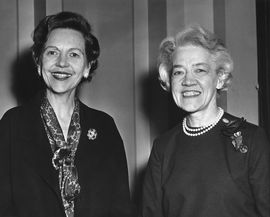
In celebration of Women’s History Month, this Senate Story highlights a historic day in 1961 when—for the first time in Senate history—two women took the oath of office on the same day.
One of the Senate’s most enduring traditions is the biennial oath-taking ceremony. A long-standing feature of this ritual is the escorting of newly elected or reelected senators to the well of the Chamber. Marching down the center aisle in pairs, or occasionally in groups of three, current and former senators, traditionally from the same state as the newly elected or reelected senator, then stand by to witness this much-anticipated moment in every Senate career.
In January of 2019, at the beginning of the 116th Congress, a record-breaking 14 women senators took the oath of office. Eight of those women were escorted by another female senator. As the number of women in Congress grows, these symbolically important moments are becoming more commonplace, but that wasn’t always the case. In fact, in 1961, the sight of two women taking the oath together caused quite a stir!
The 1960 election had already set a milestone. For the first time, two women candidates faced off against each other for the same Senate seat. One candidate was the Republican senator from Maine, Margaret Chase Smith, whose courageous stand against McCarthyism had won her national acclaim and placed her on the list of America’s most admired women. First elected to the Senate in 1948, Smith was reelected in 1954, and in 1960 she was seeking a third term. Political observers predicted an easy win for Smith, but the Democrats had a plan for victory. Their carefully chosen candidate was state representative Lucia Cormier. The only way to beat Smith, the Democrats insisted, was with another woman.
The Smith-Cormier contest quickly gained national attention. Despite the many accomplishments of both women, the press often reported the campaign in sexist terms. It was a contest of “widow vs. spinster,” declared the Los Angeles Times. We expect to see “a real fur-flying political cat fight,” predicted the Washington Post, between “a scrappy ex-school teacher” and “the snowy-maned, frosty-mannered Republican ‘queen bee.’” The campaign heated up even more in February of 1960 when Maine’s junior senator, Edmund Muskie, personally championed Cormier’s campaign. Muskie even went so far as to escort the Democratic candidate to the Senate Chamber. He introduced Cormier as “the next senator from Maine” and urged her to take a seat at one of the historic desks. This was a clear breach of Senate etiquette and something that Senator Smith did not forget.
Margaret Chase Smith won the election (and another in 1966). There were no post-election hard feelings between Smith and Cormier, who had been friends and colleagues for years, but as Smith returned to Washington to take the oath for a third time, she was none too pleased with Ed Muskie.

Less publicized but equally important, another woman made Senate history that year. On November 8, 1960, Democrat Maurine Neuberger was elected as the first (and to date, only) woman senator from the state of Oregon. A teacher, writer, photographer, and activist for consumer rights, Neuberger had served in the Oregon state legislature in the 1950s but came to Washington, D.C., when her husband, Richard, was elected to the U.S. Senate. They quickly became a high-profile Washington “power couple.” When Richard died in 1960, Maurine Neuberger ran for election to his seat, winning both a special election to fill out the remainder of his term and a general election to the full six-year term beginning in 1961. For the first time in Senate history, two women were elected to a full term in the same election and would take the oath of office on the same day. “The gap between the two parties, the distance between Portland, Maine, and Portland, Oregon, will be bridged” by two women, promised a reporter.

As the opening day of the 87th Congress arrived in January of 1961, the press paid a good deal of attention to the two women senators. Margaret Chase Smith, who for much of her career had been the only female senator, welcomed the company of another woman. Smith was also an astute politician. She understood that the oath-taking ceremony provided a perfect opportunity for a display of female solidarity in the Senate. It also provided an opportunity for some political payback.
On January 3, 1961, when Margaret Chase Smith entered the Chamber to take the oath of office, she ignored Senate tradition. In a rebuke of her Maine colleague, she walked into the Chamber arm in arm with Maurine Neuberger. The two women got a standing ovation, women in politics got a hefty boost, and Margaret Chase Smith got even with Edmund Muskie.